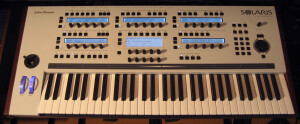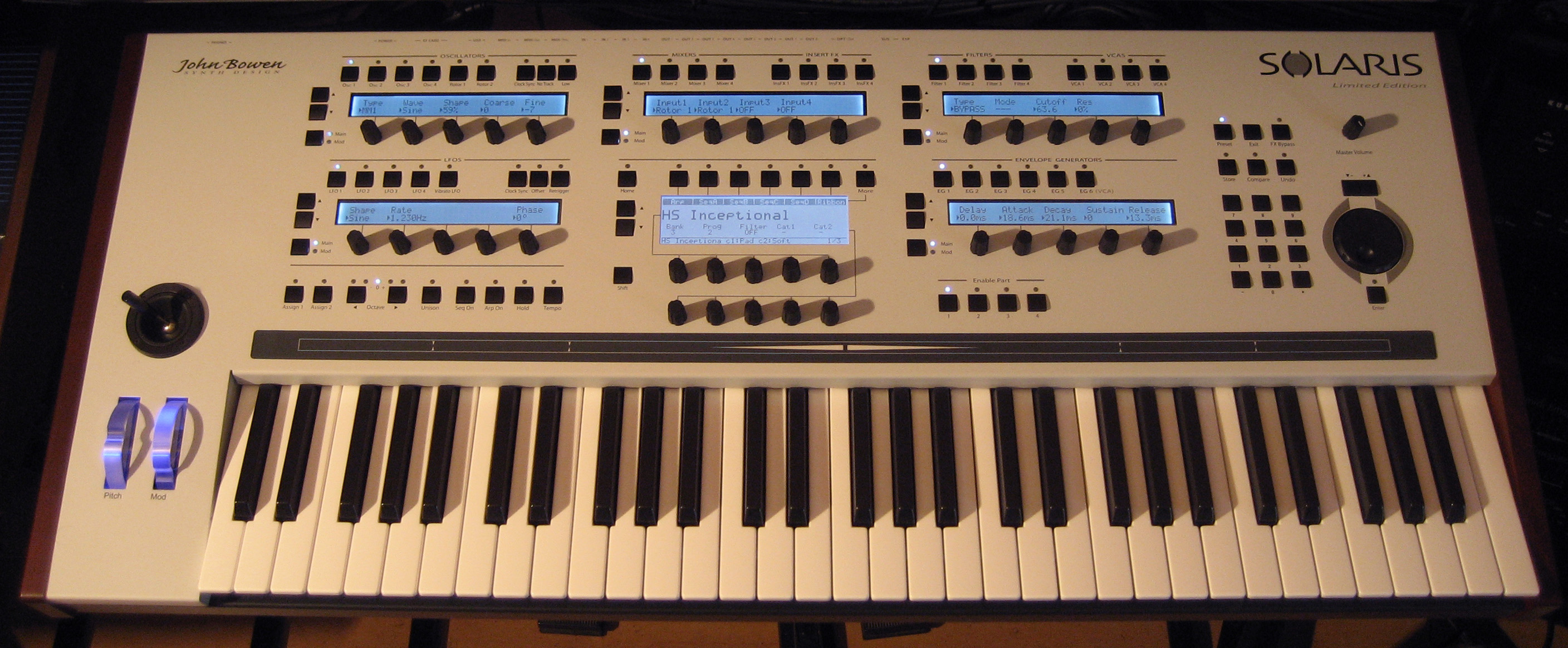[News] [Musikmesse] John Bowen Solaris
- 36 réponses
- 15 participants
- 5 377 vues
- 14 followers
Number-6
 John Bowen Synth Design sort son premier synthé, un numérique plutôt prometteur : Solaris.
John Bowen Synth Design sort son premier synthé, un numérique plutôt prometteur : Solaris.Lire la news
Ce thread a été créé automatiquement suite à la publication d'une news pour ce produit. N'hésitez pas à poster vos commentaires ici !
grabuges
Citation : I've copied my very first page posted on this forum regarding the specifications (way back in the beginning) to make some current updates, now that we are getting towards production release. I've deleted items and made changes where appropriate:
* Price - retail US price will be $3,999
* General availability - April 2009 (after all pre-sales are filled)
* 4 Oscs, 2 Rotors, 4 Mixers, 4 Filters, 4 Amp/Pan sections, 8 Envelopes, 5 LFOs, 4 External Inputs, Flanger/Chorus, Phaser, Delay, 3 band EQ, Overdrive
* 2 Vector Mixers
* 2 separate AM (amplitude modulation) sections, with Ring, AM, Rectify, & Clip algorithms
* Joystick and multi-touch Ribbon controllers
* Arpeggiator and control Step Sequencer provided, with MIDI output
* Performance buttons include 2 assignable switches, Arpeggiator Start, Sequencer Start, Hold, (Tap) Tempo, Unison
* Polyphony count - expected to be 24 voices with all 4 oscs, 4 filters, 4 mixers, envelopes, LFOs, etc. running
* 96 kHz internal processing rate
* Insert FX pre-/post each filter section, with BitCrush, Decimate, and Distortion
* 4 pair of outputs; Main pair for v1.0, additional outputs reserved for future use (when Multi-Timbre Mode is implemented)
* separate Headphone out
Detail per section:
Oscillators - each osc type selects from standard waveshapes (MultiMode Osc), wavetable (PPG) type, sample (WAV) playback, CEM (Prophet 5) type, or Prophet VS type. The MM (MultiMode) type provides the following waveshapes:
Sine, triangle, ramp, saw, pulse, noise, S&H, morphing sine-to-saw, morphing sine-to-square, and a stacked "supersaw" with varible detune (based on the Shape parameter). Hard Sync is only available for MM saw, ramp, and pulse.
New types will be added as they are developed via an upgrade to the OS.
Individual "analog-style" glide is available for each oscillator.
There are 4 mod paths. Each one is freely assignable to select exponential frequency (normal pitch mod), Linear FM, or Shape as their destination. Mod Sources include any oscillator, any filter, the 4 external inputs, any of the lfos, envelopes, controllers, etc.. A 'sidechain modulation' function is provided for each path, using Controller (non-audio rate) signals. Controller signals are all lfos and envelopes, velocity, note, aftertouch, mod wheel, ribbon, joystick, select MIDI controllers, assignable CC knobs, etc.
Filters - 4 filters, each with selectable inputs.
Filter types include:
1) all pole possibilities for the MultiMode (MM1) filter, including 24 dB Lowpass, Highpass, and Bandpass, 12 dB Lowpass, Highpass, and Bandpass, and 6 dB Lowpass, Highpass, and Bandpass, along with some other combination modes, for a total of 23 variations.
2) 24 dB Lowpass modeled on the Prophet 5 Rev1 filter (SSM2040)
3) 24 dB Lowpass modeled on the Rev 3 Prophet 5 (CEM3320)
4) 12 dB Lowpass modeled on the Oberheim SVF
5) Comb/Tube filter (the "tube" is a comb with negative feedback)
New filter types will be added as they are developed via an upgrade to the OS.
For filter modulation, it's the same structure as the Oscillators - there are 4 mod paths. Each one is freely assignable to select Cutoff, Resonance, or Damping (if Comb/Tube is selected) as their destination. Mod Sources include any oscillator, any filter, the 4 external inputs, any of the lfos, envelopes, controllers, etc.. A 'sidechain modulation' function is provided for each path, using Controller (non-audio rate) signals. Controller signals are all lfos and envelopes, velocity, note, aftertouch, mod wheel, ribbon, joystick, select MIDI controllers, assignable CC knobs, etc.
ADSRs - there are 6 standard DADSRs. Each overall amount can be modulated by Velocity, and each segment can be individually modulated from Velocity, Note, Mod Wheel, and assignable Midi Controllers (CC1-CC5). Also, each segment can have a variable slope, from linear to exponential.
Looping Envelopes - there are also 2 looping envelopes, each with 8 Time&Level segments. There is overall modulation possible of Time and Level.
LFOs - there are 5 identical LFOs, with the fifth being permanently connected to the frequency of all oscs (therefore, it is called the Vibrato LFO). The LFOs have the standard waveshape types, and range from 0-524 Hz. There are parameters for Delay Start, Fade In, Fade Out, Rate, Waveshape, Retrigger, Phase, Level, MIDI Clocking, and Offset (offset provides a positive unipolar signal for the lfo outputs). There are 3 mod paths, similar to the Oscillator modulation structure. The destinations here are selectable for Rate or Level.
VCAs - There are several models implemented for the final output stage circuit. VCA Types include: Linear, Log, and Sigma (Minimoog style). There is 1 mod path for the VCA, and 1 for the Pan position.
Vector Synthesis - There are 2 Vector Mixer sections. The Joystick (non-spring loaded) in the leftmost section is normally connected to both Vector Mixers, but can be disabled.
AM Sections - 2 Amplitude Modulation sections, each of which have Carrier, Modulator, Algorithm and Shaper parameters. Ring Mod is one of the algorithms provided.
Effects - Initially available will be delay, flanger/chorus, reverb, EQ, Overdrive. As with the other sections, additional FX types such as a vocoder or resonant filter bank will be added as they are developed via an upgrade to the OS.
All pre-order customers have been advised that Multi-Timbre Mode will not be available for the v1.0 release of Solaris. I know some have posted here that no Multi-timbre Mode would be a 'deal-breaker' for them, so I wanted to make it clear here that the first version will not have it. Those who have been reading here will also know that this was an unknown for me, and depended on a number of things in the development of the OS. We will make it a priority for one of the first upgrades to be offered.
=John b.
Au niveau aspect final : https://forums.johnbowen.com/viewtopic.php?t=490&postdays=0&postorder=asc&start=0
grabuges
Sur ce, cure de neige et saucisson au Beaufort de 15 jours pour ma pomme
Studiodragon
Une Vidéo par ici de la Musikmesse avec le maître lui même ...![]()
http://www.sonicstate.com/news/2011/04/07/messe11-john-bowen-slolaris-in-production/
[ Dernière édition du message le 09/04/2011 à 15:56:32 ]
Anonyme
A bientôt
Xa
Studiodragon
Citation de : Push-Pull
5990 euros.
Non, c'est 3'608,10 euro pour nous chez Music Store ...![]()
[ Dernière édition du message le 09/04/2011 à 16:21:17 ]
BodhGaya
La musique est un ordre de mystique, mathématiques sensuelles. Un miroir retentissant, un mode auditif de mouvement, dans sa teneur d'expression qu'elle fait appel aux émotions.
tinhu
"Switched on bach"
- < Liste des sujets
- Charte





